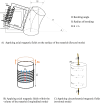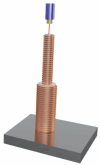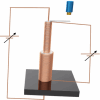Experimental characterization and modeling of a new bulk multi-mode magnetostrictive actuator
- PMID: 41224833
- PMCID: PMC12612029
- DOI: 10.1038/s41598-025-11582-x
Experimental characterization and modeling of a new bulk multi-mode magnetostrictive actuator
Abstract
In this paper, an analytical model of a new bulk magnetostrictive actuator in three modes-longitudinal, bending, and torsional-are examined. The magnetostrictive material considered is a cylindrical vanadium permendur. This actuator is capable of operating in the mentioned modes both independently and in combination. Three constant magnetic fields are used to actuate the device in axial, bending, and torsional modes, and the calculation of each magnetostrictive coefficient dij is performed by considering all magnetic fields. The longitudinal deformation is applied through the Joule effect by stimulating the magnetostrictive material with a coaxial coil surrounding the material. The torsional mode is implemented via the Wiedeman effect by passing an electric current through a wire inside the magnetostrictive material. For the bending mode, the stimulation is achieved by applying a magnetic field on a surface of the material using a magnetic coupler. The actuator modeling is conducted using classical magnetostrictive equations, and the magnetostriction coefficients are modified for the excitation magnetic fields. Experimental tests are conducted to measure the coefficients. Ultimately, the magnetostrictive deformations in three modes are precisely refined and presented using nonlinear regression relationships.
Keywords: Analytical; Bending mode; Longitudinal mode; Magnetostrictive actuator; Torsional mode.
© 2025. The Author(s).
Conflict of interest statement
Competing interests: The authors declare no competing interests.
Figures


















References
-
- Engdahl, G. & Mayergoyz, I. D. Handbook of Giant Magnetostrictive Materials Vol. 107, 1–125 (Academic Press, San Diego, 2000).
-
- Gopalakrishnan, S. Modeling of magnetostrictive materials and structures. In AIP Conference Proceedings, Vol. 1029(1), 140–157. (American Institute of Physics, 2008).
-
- Karafi, M. & Kamali, S. A continuum electro-mechanical model of ultrasonic Langevin transducers to study its frequency response. Appl. Math. Model.92, 44–62 (2021).
-
- Linnemann, K., Klinkel, S. & Wagner, W. A constitutive model for magnetostrictive and piezoelectric materials. Int. J. Solids Struct.46(5), 1149–1166 (2009).
-
- Lin, C. H. & Lin, Y. Z. Analysis of nonlinear piezomagnetism for magnetostrictive terfenol-D composites. J. Magn. Magn. Mater.540, 168490 (2021).
LinkOut - more resources
Full Text Sources

